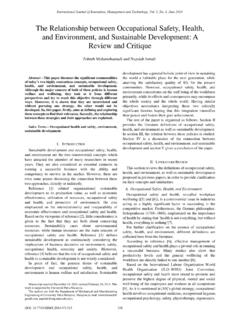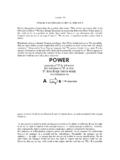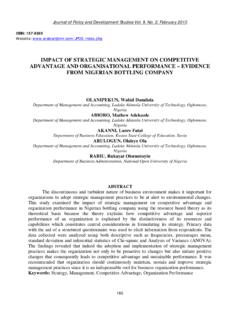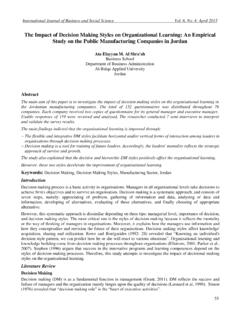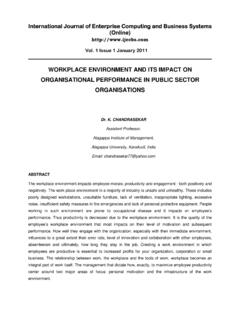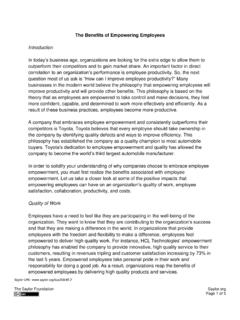Transcription of The Resource-Based Theory of Competitive Advantage ...
1 The Resource-Based Theory of Competitive Advantage : Implications for Strategy Formulation Robert Grant (CMR 1991) Porter s strategic development process starts by looking at the relative position of a firm in a specific industry. This is, we start by considering the firm s environment and then try to assess what strategy is the one that may maximize the firm s performance. The Resource-Based (RB) Theory , by contrast, can be seen as an inside-out process of strategy formulation. We start by looking at what resources the firm possesses. Next, we assess their potential for value generation and end up by defining a strategy that will allow us to capture the maximum of value in a sustainable way. The process is summarized in the graph below: 4.
2 Select a strategy which best exploits the firm s resources and capabilities relative to external opportunities3. Appraise the rent generating potential of resources and capabilities in terms of a) their potential for sustainable CAb) the appropriability of their returns2. Identify the firm s capabilities: What can the firm do more effectively than its rivals? Identify the resources inputs to each capability, and the complexity of each capability1. Identify and classify the firm s resources. Appraise strengths and weaknesses relative to competitors. Identify opportunities for better utilization of resources5. Identify resource gaps which need to be filled. Invest in replenishing, augmenting and upgrading the firm s resource baseCapabilitiesResourcesStrategyCompeti tiveAdvantageA Resource-Based Approach to Strategy Analysis: A Practical framework Why looking at industry and positioning alone is flawed?
3 Industry: lots of studies fail to prove the relationship between firm performance and industry Positioning within the industry is mostly determined by the firm s resource base Resources and Capabilities: the starting point Starting point for strategy formulation has to be a statement of the firm s identity. In Porter, this is given by determining the boundaries of the firm within an industry. Here we will use the stock of resources and capabilities that a firm has. Definitions: Resources are inputs into the production process. They are the basic unit of analysis (capital equipment, skills of employees, patents, ) o Basic categories: financial, physical, human, technological, reputational and organizational Capabilities: Capacity for a team of resources to perform some task or activity.
4 They constitute the main source of Competitive Advantage o Hamel and Prahalad call core competencies to those that are crucial for the organization s CA. Among them, collective learning in the organization is seen as the crucial one. o Problem in apprising Cs is to objectivity Routines: Routines are regular and predictable patterns of activity which are made up of a sequence of coordinated actions by individuals. (Nelson and Winter). They are the result of the repeated interaction (learning) between people and other resources of the firm. relationship between resources, capabilities and routines: o R-C: The capacity of the organization to cooperate and coordinate resources can be seen itself as an intangible resource o Trade off efficiency-flexibility: routines involve a high degree of semi-automatism or tacit knowledge, and this limits to which organization s capabilities can be articulated o Economies of experience: The Advantage of an established firm over a newcomer is its greater experience.
5 This was reflected in the 60s-70s with the emphasis on learning curves (BCG s experience curve). Less important the more dynamic the environment is. o Complexity of Capabilities: Complex organizational capabilities pose a huge barrier for other firms to enter the market making it easier to sustain its CA complexity is specially relevant for the sustainability of CA. Earning positive returns on the value that your resources originate depend on its sustainability and appropriability Sustainability Two main sources of CA erosion over time: depreciation and imitation by rivals. The four main elements for the sustainability of CA derived from your resources are: Durability: rate at which resources depreciate or become obsolete Transparency: Imperfect transparency implies uncertain imitability Transferability: If a rival can easily acquire the resources that you have, your CA will quickly fade away.
6 What makes for resources that are difficult to imitate?: geographical immobility, imperfect information, firm-specific resources, immobile Replicability: If acquisition of resources is not possible, rivals may want to grow the resources inside his organization. The more complex the organizational routines are, the more difficult it will be to replicate them. Appropriability In order to be of real value to their investors firms must not only create and sustain their CA. They also have to be able to capture the rents derived from their activity. These rents are not only challenged by the firms rivals, but also by its customers, workers and other stakeholders. With respect to their workers, for example, the more embedded are organizational routines within groups of individuals and the more are they supported by the contributions of other resources, then the greater is the control that the firm s management can exercise.
7 Formulating strategy Until here we have determined that the firm s most important resources are those that are durable, difficult to identify and understand, imperfectly transferable, not easily replicated and in which the firm possesses ownership and control. Now, the crux of strategy formulation is to define a strategy that makes the best use of these resources and (interesting idea how do we do it?) Two issues that come up often in the literature on RBV have to do with the limits of the firm do we only get into those business for which we are well endowed and leave everything else out of the picture?- and with the relevant strategic time frame for how long will the present resources and capabilities of my firm will provide a CA over my competitors?
8 -. Identifying resource gaps and developing the resource base. In order to sustain the firm s CA it is necessary that it keeps nurturing and developing its resource base. Resources can be seen as stocks that depreciate with time and that have to be replaced, augmented and upgraded. Here we find a parallel with Porter s diamond in that in both models, the only way to stay in the market is through upgrading the resource pool remind that Porter considers innovation as the force creating CA-. This resource pool can be upgraded organically or through acquisitions. Notice that if constant innovation is the key to sustainable CA, it is crucial for management to be committed to the necessary investments to carry this process out.











